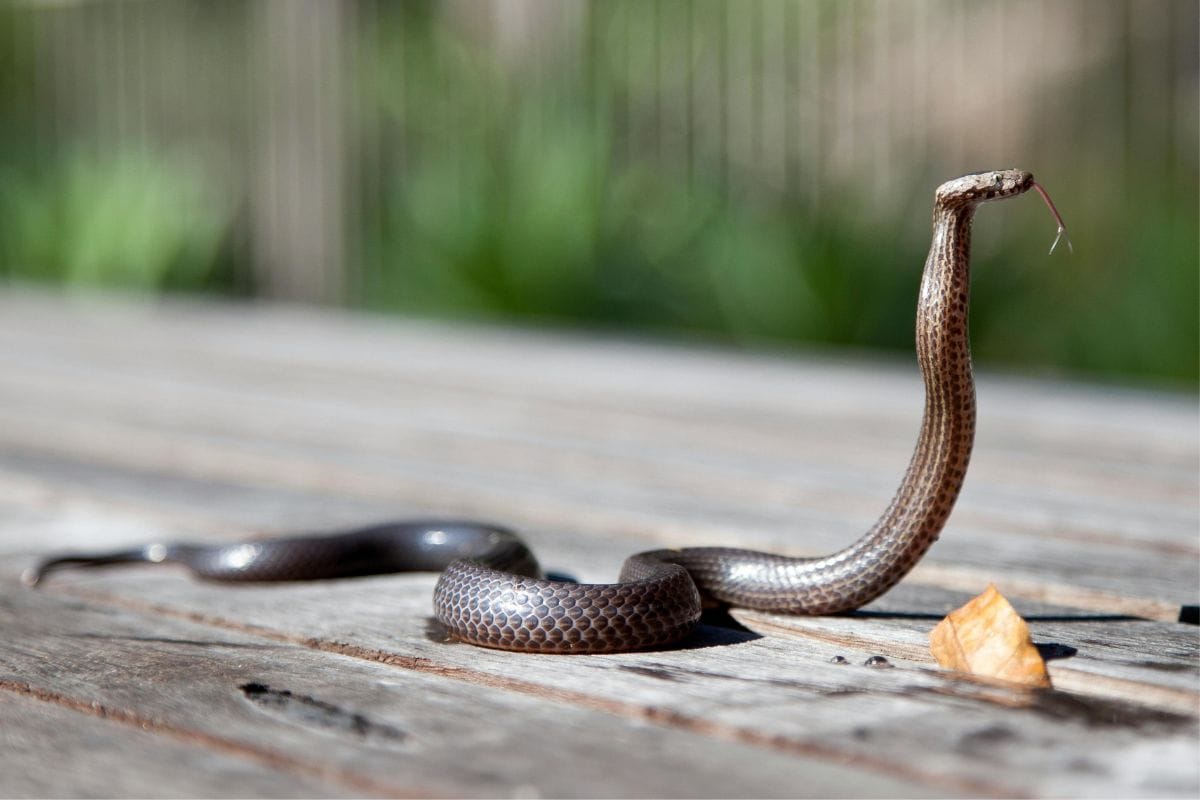Yes, some snakes can cross ropes, especially if they’re good climbers and the rope provides enough grip.
You may have heard the enduring myth that snakes will not cross a rope—a belief that has found its way into camping lore and has been passed down through generations.
Rooted in the idea that certain types of ropes, particularly horse hair or braided ones, could act as a deterrent or barrier to these slithering creatures. This concept often is supported by anecdotal evidence of cowboys encircling themselves with ropes to keep snakes at bay while sleeping outdoors.
However, scientific observation and facts tell a different story. Snakes, as ectothermic animals, navigate their environment primarily based on sensory cues and the search for warmth, food, and safety.
The texture or material of a rope does not inherently pose a threat or obstacle that a snake can’t overcome. There isn’t a consistent behavior pattern showing that snakes actively avoid ropes when they come across them in nature.
Observations and controlled experiments with snakes show that they are capable of crossing over ropes without hesitation when motivated, regardless of the rope’s material. The avoidance of ropes by snakes is not a behavior that can be counted upon as a reliable snake deterrent.
There are more efficient and scientifically supported methods to prevent an encounter with snakes, which focus on altering the environment to make it less attractive to them, rather than relying on a rope to act as a protective barrier.
Understanding Snake Behavior

In understanding snake behavior, you need to consider their unique sensory systems and how they interact with their environment.
Common myths often misrepresent these behaviors, but scientific evidence provides clarity.
Sensory Systems and Environment Interactions
Your comprehension of snake behavior hinges on recognizing their advanced sensory systems.
Snakes utilize heat receptors and a keen sense of smell to locate prey and navigate through their environment.
Heat receptors, especially in pit viper species, allow them to detect minute changes in temperature, essentially allowing them to “see” the heat radiating from warm-blooded animals. This ability is pivotal in hunting, especially at night or in places where visual cues are minimal.
In contrast, their vision varies significantly across different species, with some snakes having good eyesight while others are nearly blind. Furthermore, snakes experience their world predominantly through taste—their forked tongues collect airborne particles which are then processed through the Jacobson’s organ to give them a detailed understanding of their surroundings.
Snakes detect vibrations in the ground to sense approaching prey or threats, compensating for their poor hearing capabilities.
Their belly scales aid in movement by gripping surfaces as they slither, vital for both hunting and escaping predators. The relationship between their finely-tuned senses and movement is a demonstration of how well-adapted reptiles are for their habitual survival.
Find out 🐍 How To Prevent Snake Bites While Hiking
Common Myths Versus Scientific Evidence
Common myths about snakes often arise from a misunderstanding of their behavior and instincts. One such myth is that snakes cannot cross ropes.
However, scientific evidence debunks this claim. Snakes will cross objects, including ropes, if there’s an incentive or necessity, driven by their instincts to hunt or evade fear.
While a rope might initially cause hesitation due to its unfamiliar texture against the snake’s belly, these reptiles have no inherent aversion to such objects.
Remember, snake behavior is influenced by environmental factors as they are constantly analyzing the risk versus reward—whether the need is to pursue prey or escape a perceived threat, such as humans. By discerning real snake behavior from fiction, you can gain a better understanding of these oft-misunderstood species.
Will Snakes Cross a Rope?

Your understanding of snake behavior in relation to their environment plays a role in evaluating the validity of the rope theory.
The Rope Barrier Theory
You might have heard that snakes are reluctant to cross ropes due to the texture or shape being perceived as a threat or an obstacle.
The theory assumes that the rope, laid across a snake’s path, functions as a barrier. However, contrary to popular belief, your perception of a rope as an obstacle may not align with a snake’s.
Experiments and Findings
Researchers have conducted experiments to understand this behavior.
The results demonstrate that snakes can indeed cross ropes and often do so without hesitation. The texture of a rope is not significantly different from short grass or the terrain they regularly encounter.
There is not enough scientific proof to conclude that a rope always acts as an effective barrier.
No products found.
Snake Repellents and Deterrents
When considering how to deter snakes from certain areas, you’ll find both commercial repellents and home remedies.
The effectiveness of various materials as deterrents is also a topic of debate; not all substances are equally discouraging to snakes.
Commercial Repellents and Home Remedies
Commercial snake repellents often contain chemicals like naphthalene or sulfur, which are believed to discourage snakes due to the strong smell.
Specific brands might have different active ingredients, but these are common. For example, mothballs, incorporating naphthalene, are sometimes used, although their effectiveness is scientifically questionable.
Home remedies range from ammonia-soaked rags to lemon detergent, which are used with the belief that their smells can scare away snakes.
However, these methods lack robust scientific backing, and results can be inconsistent.
- What works:
- Commercial repellents containing proven ingredients.
- Physical barriers or snake-proof fencing.
- What might not work:
- Homemade solutions like lemon detergent, sulfur, or ammonia.
Effectiveness of Different Materials

The effectiveness of materials as snake deterrents varies.
Solid barriers like specialty snake fences are the most reliable form of physical deterrent, designed to keep snakes out by providing an impenetrable barricade.
Their success lies in their structure rather than relying on a snake’s reaction to certain smells or vibrations.
On the matter of whether materials like ropes deter snakes, the consensus among various studies is that snakes will cross most materials, including ropes, without hesitation.
There’s little evidence to suggest that vibration or texture, such as that provided by a braided rope, has any reliable repellent effect.
- Materials to consider:
- Snake-proof fencing
- Certain commercially available chemical repellents
- Materials with insufficient evidence:
- Household materials that rely on odor or texture, such as ropes.
Practical Measures for Snake Prevention
To effectively deter snakes from your property or while spending time outdoors, integrating specific physical barriers and behavioral strategies can be crucial.
By understanding snake behavior and habitat preferences, you can create an environment that is less enticing to these reptiles.
No products found.Physical Barriers and Landscaping
- Fences: Construct a solid, anti-snake fence around your property’s perimeter. Ensure the fence is flush with the ground and has fine mesh or plastic sheeting to prevent snakes from entering. The fence should be at least 36 inches high to discourage climbers.
- Gardens: Keep your garden tidy by eliminating debris and reducing dense vegetation where snakes may hide. Use gravel or hardscaping near the home’s foundation to create an unattractive area for snakes.
| Landscape Feature | Recommendations |
|---|---|
| Grass | Maintain short lawn height; long grass can provide cover for snakes. |
| Garage and Buildings | Seal any cracks or gaps where snakes could enter. |
Behavioral Strategies for Campers and Homeowners
When camping:
- Campground: Choose open, clear areas away from thick underbrush or heavy woods.
- Tent: Pitch your tent in the center of the clear area, and use a solid ground cover that extends beyond the tent’s perimeter.
- Sleeping Bag: Always zip up your sleeping bag and tent to minimize entry points.
At home:
- Human Presence: Frequent yard activity can serve as a deterrent, as most snakes prefer to avoid humans. Keep areas of congregation like patios and play areas free from dense shrubbery.
- Safeguarding the Home: Regularly inspect your garage and home for potential snake access points. Secure screens on windows and doors, and consider installing door sweeps.
Remember to avoid relying on unproven methods like rope barriers, as there is little evidence to substantiate their effectiveness in repelling snakes. Instead, focus on maintaining clear, open spaces and securing potential entry points to reduce the likelihood of a snake encounter.






